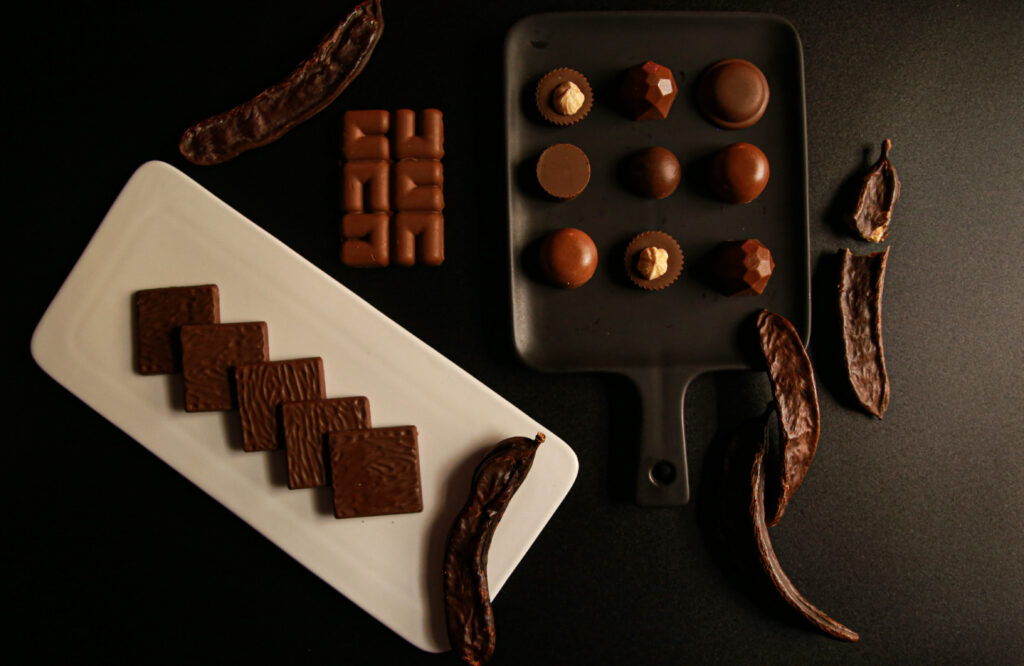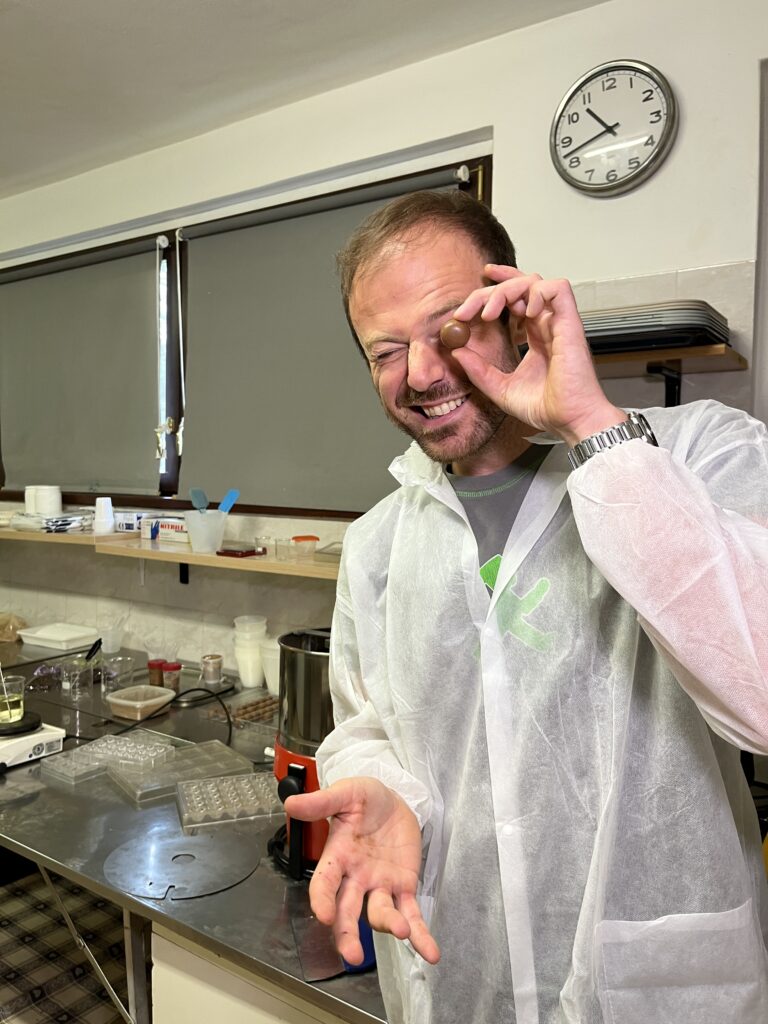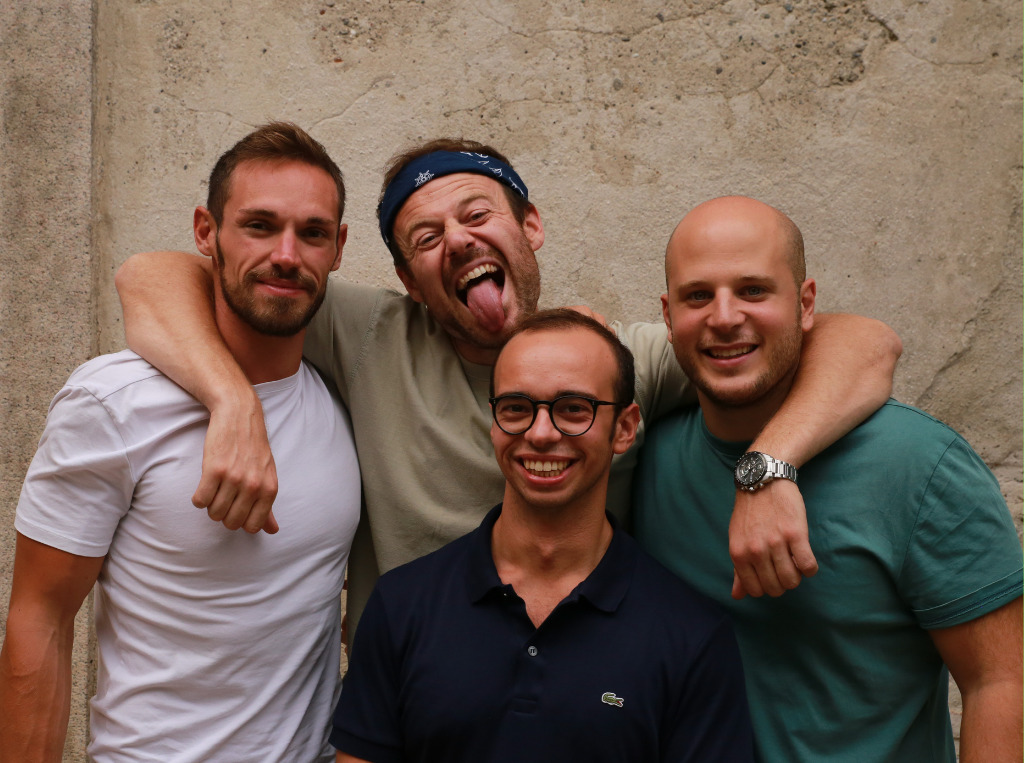6 Mins Read
Based in Southern Italy, Foreverland is the latest cocoa-free producer making a sustainable alternative to chocolate. Its co-founder Giuseppe D’Alessandro speaks to Green Queen about its Freecao chocolate, what sets it apart from other brands, and subverting the distaste for carob.
Having been in stealth mode for a while, Foreverland is today introducing its chocolate alternative called Freecao, made from a base of carob. Based in Bari, Puglia – a region (like all of Italy, really) renowned for its culinary prowess – the brand is the brainchild of Giuseppe D’Alessandro, Massimo Sabatini, Riccardo Bottiroli and Massimo Brochetta, who all have previous experience in multinational corporations and the food industry.
Foreverland points to the climate and labour shortfalls of cocoa production to explain its origin. Across the supply chain, dark chocolate is the second-highest GHG-emitting food, with a higher land use change impact than even beef. And in terms of carbon opportunity costs – the amount of carbon lost from native vegetation and soils to produce food – cocoa beans rank third after goat and sheep meat, and beef and buffalo meat.
In addition, the chocolate industry is a major driver of deforestation in cocoa-producing areas. In 2020, over 40% of Italian cocoa bean imports came from the Ivory Coast and 18% from Ghana. The former – the largest cocoa producer in the world – has lost over 85% of its forestland since 1960. Additionally, most industrial chocolate contains palm oil, which is responsible for widespread tropical deforestation.
Both industries have human rights and labour issues too. Land cleared to grow more palm oil trees has led to the displacement of many Indigenous populations, while the chocolate industry has been linked to child slavery.
Foreverland’s solution to this is to eschew cocoa for carob, a native Mediterranean legume. Italy is the world’s second-largest producer of the ingredient, topped only by Portugal. It’s known as a nutritional powerhouse and has been used as an alt-chocolate ingredient since the 1970s by health food brands, but Foreverlan says it’s using modern tech to transform the “organoleptic properties” of cocoa.

Its Freecao is free from the nine major allergens and contains up to 50% less sugar than traditional milk chocolate. The startup has been selected for the sustainability-focused MassChallenge accelerator in Switzerland. D’Alessandro spoke to Green Queen about Foreverland’s journey and future ambitions.
This interview has been edited for clarity and concision.
Green Queen: Can you share more about the ingredients and composition of your chocolate?
Giuseppe D’Alessandro: Our Freecao contains carob, together with a blend of different grains, sugar and label-friendly vegetable fats (palm-free, no trans-fats).
GQ: What is your fat source? What is your sugar/sweetener source?
GA: [Our] fat source is a blend of vegetable fats made of more sustainable cocoa butter alternatives, including shea butter, which is palm-free and clean label (not hydrogenated, not trans-esterified).
[Our] sugar source is mainly carob, which is naturally sweet, allowing us to achieve 25-50% less sugar in the final chocolate depending on the application. [There are] o sweeteners in our formulation.
GQ: Do you have your own production facility or do you use co-manufacturing?
GA: At the moment, we are releasing small batches of Freecao for market validation through a network of co-manufacturers, but in parallel, we are working on setting up a production facility fully operative by the end of next year in Puglia, where carob trees are grown.
GQ: What scale of production are you at?
GA: We’re at a pilot/semi-industrial scale. By the end of the year, we will release 5,000 chocolate pralines for consumer validation and 1,000 bags of Freecao vegan milk chocolate drops for B2B validation through foodservice.
GQ: How are you different from the other cacao-free players out there? You’ve mentioned a better-for-you angle – can you expand?
GA: In our opinion, we differ from the other players because of the following pillars:
We focus on Mediterranean ingredients and local sourcing.
We go beyond sustainability, including the wellbeing of people in our value proposition, [and] proposing products that are naturally vegan, top-nine-allergen free, and reduced added sugar. We do believe that for being future-proof, chocolate should be better for the planet and for the people.
We have a horizontal product portfolio that goes behind chocolate. By the end of the year, we will have also our MVP of the Freecao spread ready: a Nutella-like product without cacao and free from allergens (including hazelnut paste) but still with comparable sensory properties.

GQ: Are you using precision fermentation? Or cellular agriculture? Or is Freecao made via traditional fermentation?
GA: We are not using precision fermentation or cellular agriculture methods. Our technological platform includes traditional fermentation alongside other existing processing label-friendly technologies that we meticulously adapt to our raw materials. This allows us to create products that do not require regulatory approval before commercialisation.
GQ: Are you more focused on building a B2B company and being an ingredient or are you creating a B2C company and building a brand?
GA: Our goal is to create the biggest impact possible, so in the long term, we aim to become the strategic supplier of cocoa-free chocolate for the top confectionery industry [companies] in the world. Initially, we will focus on the foodservice channel to create the traction we need to work with big players. In parallel, we believe that in the next few years, consumers will become more and more aware of the issues linked with chocolate production, so we are also launching a ‘satellite’ B2C brand to get a better understanding of the consumer’s needs, as well as further validation of our chocolate in different forms and applications.
GQ: Have you tested your chocolate with the big industry players like Nestlé or artisan chocolatiers?
GA: Yes, we tested our chocolate with chocolate insiders of different sizes in Italy (artisanal chocolate makers, SMEs producing chocolate and a big chocolate industry [company]), and validated Freecao for 1:1 replacement of conventional chocolate.
GQ: How much have you fundraised so far?
GA: We raised €200K from business angels and from EU-based VCs. Next to this, we are activating grants from South Italy for enhancing development in rural areas of the region.

GQ: You are using carob, a chocolate alternative that has been used by health-forward brands in the US and beyond since the 1970s, especially to cater to people avoiding caffeine or who are allergic to cacao. It has not caught on in the mainstream. What makes your product different?
GA: It’s true that our main ingredient is carob, but if you simply add carob to chocolate (like the US was doing in the 70s), you will not get a product that tastes as good as our Freecao. That is the complexity and uniqueness of our product: by applying different label-friendly processes (including traditional fermentation), we can create a new ingredient starting from carob that more closely imitates the taste and flavour of cocoa.
Moreover, in the past, nobody was interested in the story behind carob and its unique advantages when talking about climate change and human nutrition. Indeed, carob has drought-resistant properties –[it] does not require irrigation [as] rainwater is sufficient – properties linked to the concept of superfoods, [and is] high in fibre, rich in vitamins and minerals, [and] rich in polyphenols and antioxidants.
[It also has] strong historical values. In the past, carob was significant for human nutrition, as well as a traditional remedy, especially during times of scarcity or famine, such as during World War II, when it became an important substitute for sweets and chocolates used by the Italian population.
[Carob has] huge potential as a byproduct for upcycling. Today, only carob seeds are used in the food industry to produce locust bean gum (a thickening agent) – 90% of the fruit is usually wasted away. We use this byproduct in our Freecao.




